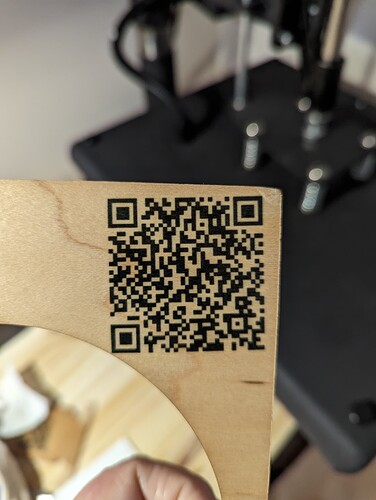I threw a piece of Proofgrade plywood into my heat press and it seemed to take a sublimation transfer well. Is there any reason I shouldn’t do this? Any durability concerns?
Pic?
No idea about your question unfortunately.
Was there warping? I put some wood in my heat press and sometimes it warps.
I’ve done this before and it works Ok.
Here are a few observations…
Yes, sometimes some types of plywood warp a bit. If you fiddle with the time and temperature you’re using in the heat press you can reduce that. I also weigh down the plywood until it cools, which also helps a bit.
The resulting ink on the plywood transfers much better if the plywood is very smooth. I give it a quick fine sanding, clean off the dust, and it’s good to go.
The colors will be muted since it’s being transferred to a non-white base surface. Someone recommended that I apply a paint white wash to the plywood first, but I haven’t tried that yet.
Also, the sublimation ink WILL come off if rubbed with isopropyl alcohol, which I learned while removing soot marks. I can just mask the wood instead to eliminate soot issues.
Here’s a photo of an untreated sublimated plywood experiment I tried recently. Go ALL the way to the bottom of my post to see it (aka “Fancy Plywood 3.0”
makes me wonder if PG maybe isn’t the best medium, since it’s already finished. but you could sublimate on non-finished plywood and then put a finish on it that would protect the surface.
not that i’d expect your final wood product is going to come into contact w/alcohol, but…
Yes, you’re right. I do always end up putting a quick spray of clear-coat on sublimated wood.
The sublimation could/might fade in time. The key to sublimation printing is the bonding of the ink as it gasses out to the polyester. I have successfully sublimated to both clear and white acrylic, but both material show the colors to be muted as the bonding is not as strong as to polyester. I have thought about trying HDPE, but it melts so easily that I haven’t.
You had me worried, since I’m getting good results with both Proofgrade plywood, and plywood I’ve pre-treated with sanding sealer or polycrylic.
I rubbed the sublimated PG ply with isopropyl alcohol and it didn’t remove the ink from the finished wood. I also tried really working it with an alcohol prep pad, that didn’t remove the ink either.
Was that only unfinished wood you sublimated that didn’t hold the ink when cleaned?
I sublimated on to unfinished non-PG plywood for this experiment. Sorry to startle you! ![]()
A few updates in case someone else reads this thread in the future looking for info:
I bought a bunch of Proofgrade Light Basswood Ply when it was on 50% off sale. It did not sublimate, the ink barely transferred to it. So Proofgrade having a clear coat that’s compatible with sublimation is not something that can be relied on.
In other news, Minwax Sanding Sealer makes a workable, cheap, easy to apply sublimation coating for unfinished wood. One good layer, let it dry for 30-60 minutes, then sand with a very fine grit to smooth. I did my first test with this almost 6 months ago and have had those pieces out on a shelf for the 6 months. The prints have not faded.
To get a good print on the homemade sublimation plywood, tape the print very tightly around two sides of the wood, put butcher paper under and over the wood in the press, and use a sheet of teflon non-stick sheet on top of that. Normally (I’m told, I’m not an expert) you don’t use teflon sheets often with sublimation since it’ll pick up the dye, which is why I have another sheet of butcher paper between the print and the teflon sheet to catch it.
Without the teflon sheet, something about the sealer-coated wood is making it stick to the top platen of the heat press momentarily when opening the press even through butcher paper. This results in smudged prints as there’s a tiny shift of the paper/wood contact area when the dye is still sublimating. With the teflon sheet, it doesn’t stick at all. After pressing, you can remove the transfer while hot. Some of the paper will likely stick to the wood, but it’ll come right off with a wet wipe or another quick sand.
